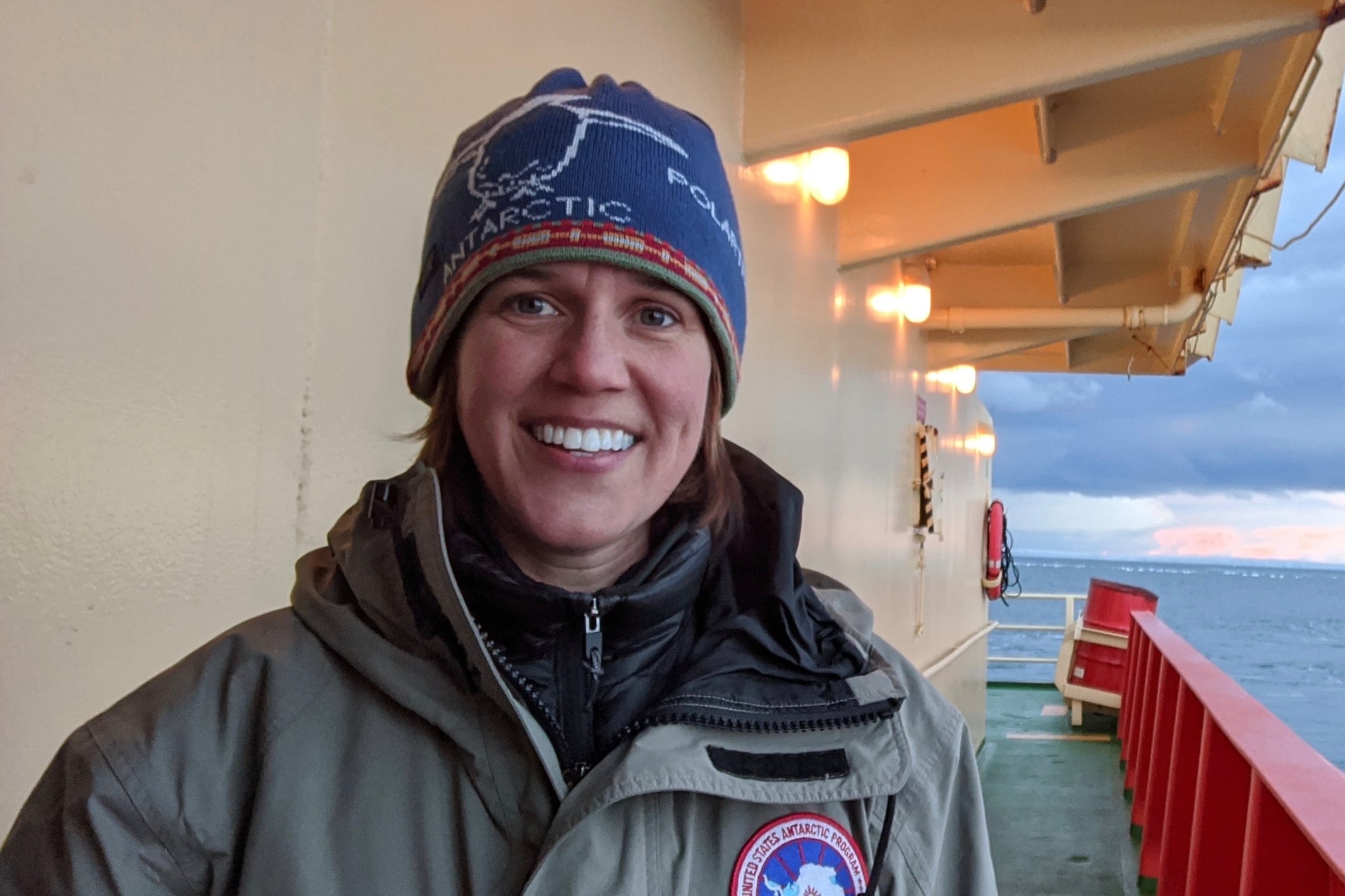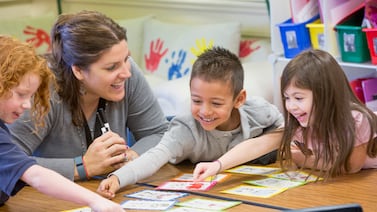Sarah Slack’s career as an award-winning eighth grade science teacher was sparked by a story about misinformation.
A student asked her friend, a New York City elementary school teacher, how Pluto blew up. Her friend, confused, dug around a bit, and discovered that his school’s science teacher, having heard on the news that Pluto was no longer a planet, told her students it had exploded. (Pluto is now considered a “dwarf planet” rather than a major planet; it didn’t, for the record, explode.)
“I thought, ‘Kids deserve access to better science information than that!’ And here I am,” said Slack, now in her 14th year in New York City public schools and a recent recipient of the prestigious Math for America Muller Award, in recognition of her influence on the profession.
Slack became a teacher through the New York City Teaching Fellows program after running a nature center in southern Massachusetts, and she has always kept climate education at the forefront of her work.
She’s on the city’s Climate Education Leadership Team, meeting regularly with a group of colleagues from across the school system dedicated to improving climate change education. (They are organizing “climate teach-ins” with guest speakers, hands-on activities, and field trips.) As a member of the Climate and Resilience Education Task Force, she joins other educators and members from local and national nonprofits to discuss teacher support as well as education policy changes at the state level.
For the past six years, Slack has been at I.S. 223 in Borough Park, Brooklyn. There, she’s tapped available resources as well as her own research experiences — including work she’s done in Antarctica and with NASA — to create a climate-focused STEM curriculum. The students do hands-on investigations, looking at temperature variation around the school and proposing changes to bolster resilience in the face of extreme heat events.
“What I’ve begun to see with my students is that, instead of making them feel they have to save the world, I can help them see how to save their own communities,” Slack said.
This interview has been lightly edited for length and clarity.
What’s your favorite lesson to teach and why?
I always thought I would most enjoy teaching lessons connected to environmental issues, but I have developed a secret (and now I guess quite public) love for physics lessons.
It started when I borrowed a pair of ill-fitting rollerblades from my roommate, wobbled on them in the front of my class, and then asked a kid to chuck a heavy backpack at me. When I managed to catch it without falling, kids watched me slowly roll backwards and we were able to discuss Newton’s second law, conservation of momentum, and friction.
Students then design and conduct their own experiments that demonstrate one of Newton’s laws. It is collaborative, interactive, occasionally dangerous, and so much fun for both me and the kids. I love to watch them engaging in the work of scientists and engineers and learning from the process as much as from the end result of their experiment.
NASA! Antarctica! Amazing!! How did these research trips shape what you bring to the classroom?
One of my favorite parts about being a teacher is that there are so many opportunities to grow in both my practice and my knowledge of science, and I am constantly seeking out ways to bring new ideas, new energy, new skills, new joy into my classroom.
Being part of Math for America is one of those ways — I took a workshop led by Alexandra Horowitz, author of “Inside of a Dog,” and ended up using her research on dog cognition to inspire a lesson on genetics and heredity based on dog breed characteristics. I was able to bring my own two rescue mutts into the classroom and challenge students to make predictions about their breed composition.
I was fortunate to have the chance to work on a research team at NASA as part of the Climate Change Research Initiative. This provided me with access to cutting-edge climate science, subject matter experts, and support to design lessons that incorporate NASA resources into our classroom activities. I have often struggled with ways to make data more interesting to my students, and making that connection to NASA research provides a little bit of a hook to get them engaged.
Certainly, one of the coolest things (both literally and figuratively) that I’ve done was participate in a PolarTREC program that allowed me to spend two months on an icebreaker off the southwest coast of Antarctica as part of an expedition investigating factors affecting the melt rate of the Thwaites Glacier. I loved being a member of a team of scientists exploring such a remote part of the world, and devising ways to incorporate my experiences into my teaching.
I’m curious to hear about your students’ sense of agency when it comes to climate and the environment. It’s pretty grim to think about the direction our planet is heading. Do they also have hope that things will change and that they can be change agents?
I show students a visualization of month-to-month carbon dioxide levels in the atmosphere from 2002 to the present (NASA’s Climate Time Machine) and use the data to color in three world maps: one that represents carbon dioxide levels in April of 2003; one that shows the data from April 2013; and lastly, a prediction of what atmospheric carbon dioxide levels will look like in April 2023, a challenge which created a spike in demand for red colored pencils in my classroom.
After showing this visualization to one class, a student with a stricken look on her face said with heartbreaking despair, “But Miss, what are we going to do?” Great question, and one that requires a much deeper exploration of the topic than just covering the basic facts of global warming causes and effects. How can we teach about this monumentally consequential topic without simultaneously instilling a sense of helplessness in the face of imminent disaster?
My classes have spent a lot of time this year measuring the temperature of different surfaces around our school — cement, pavement, dirt, and grass. Their data shows that pavement can be as much as 40 degrees hotter than grass on warm sunny days and close to 30 hotter than cement. This has triggered intense indignation about the paved school yard vs the adjacent cement administrator’s parking lot.
But following the whining and without prompting, my students began to think of solutions. What if we painted the pavement? What if we planted some trees? What if we replaced the asphalt with grass? Any or all of those things might make our community a little more resilient as extreme heat days increase in frequency in the coming years.
This recent NY Times article about the dearth of climate education in middle school made me think of your work and whether you feel like you have enough time and support to teach about climate change.
The article struck close to home. I’ve long been disappointed in the focus that the NGSS [Next Generation Science Standards] pays to climate science. I think there are a few things that could be done:
- Changing the NGSS seems unrealistic, but finding ways to encourage the curriculum writers to build more lessons around climate change science doesn’t seem like an impossible solution.
- Making sure that people don’t view climate education as exclusively a science teacher’s purview. There are plenty of ways to talk about climate in math, ELA, and social studies classes. Even art and music and drama teachers can find ways to connect their lessons to the climate crisis.
- Increase the role of Sustainability Coordinators in schools and provide them with time in their schedules to support other teachers in improving the quality of climate education. If I had a few periods a week where I was able to push into other classrooms to help to lead a lesson or work on resource development, I could reach a much larger audience.
Even if we aren’t explicitly teaching our students about climate, we can help them develop the scientific thinking skills to critically assess the ways in which our planet is changing and recognize that climate deniers are not basing their claims on any real science.
My favorite Neil deGrasse Tyson quote is: “The good thing about science is that it is true whether or not you believe in it.”








